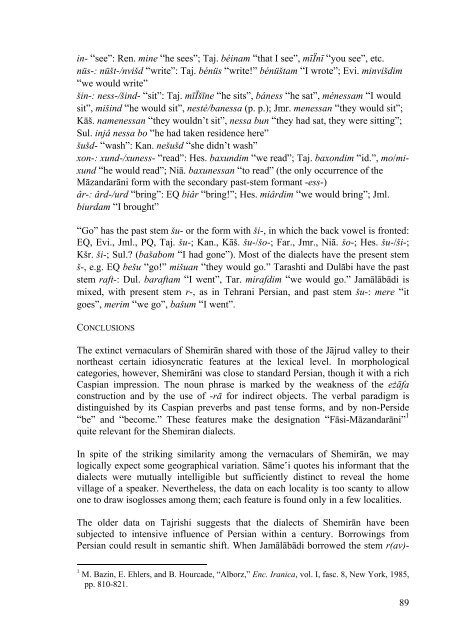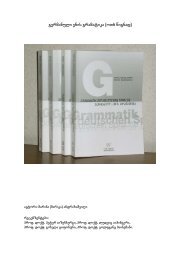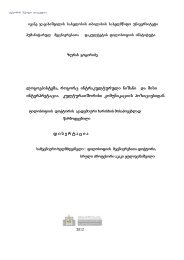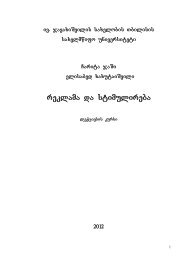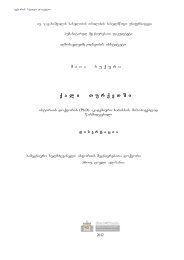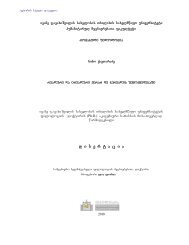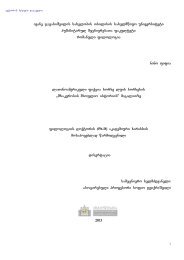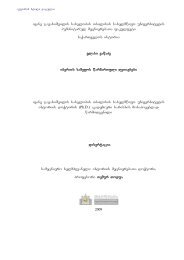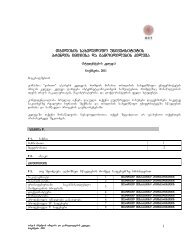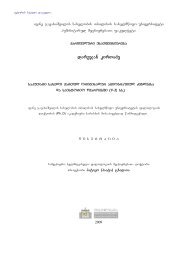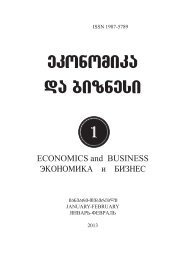issues of linguistics - Tbilisi State University
issues of linguistics - Tbilisi State University
issues of linguistics - Tbilisi State University
Create successful ePaper yourself
Turn your PDF publications into a flip-book with our unique Google optimized e-Paper software.
in- “see”: Ren. mine “he sees”; Taj. béinam “that I see”, mīÏnī “you see”, etc.<br />
nüs-: nüšt-/nvišd “write”: Taj. bénüs “write!” bénüštam “I wrote”; Evi. minvišdim<br />
“we would write”<br />
šin-: ness-/šind- “sit”: Taj. mīÏšīne “he sits”, báness “he sat”, ménessam “I would<br />
sit”, mišind “he would sit”, nesté/banessa (p. p.); Jmr. menessan “they would sit”;<br />
Kāš. namenessan “they wouldn’t sit”, nessa bun “they had sat, they were sitting”;<br />
Sul. injâ nessa bo “he had taken residence here”<br />
šušd- “wash”: Kan. nešušd “she didn’t wash”<br />
xon-: xund-/xuness- “read”: Hes. baxundim “we read”; Taj. baxondim “id.”, mo/mixund<br />
“he would read”; Niā. baxunessan “to read” (the only occurrence <strong>of</strong> the<br />
Māzandarāni form with the secondary past-stem formant -ess-)<br />
âr-: ârd-/urd “bring”: EQ biâr “bring!”; Hes. miârdim “we would bring”; Jml.<br />
biurdam “I brought”<br />
“Go” has the past stem šu- or the form with ši-, in which the back vowel is fronted:<br />
EQ, Evi., Jml., PQ, Taj. šu-; Kan., Kāš. šu-/šo-; Far., Jmr., Niā. šo-; Hes. šu-/ši-;<br />
Kšr. ši-; Sul.? (bašabom “I had gone”). Most <strong>of</strong> the dialects have the present stem<br />
š-, e.g. EQ bešu “go!” mišuan “they would go.” Tarashti and Dulābi have the past<br />
stem raft-: Dul. baraftam “I went”, Tar. mirafdim “we would go.” Jamālābādi is<br />
mixed, with present stem r-, as in Tehrani Persian, and past stem šu-: mere “it<br />
goes”, merim “we go”, bašum “I went”.<br />
CONCLUSIONS<br />
The extinct vernaculars <strong>of</strong> Shemirān shared with those <strong>of</strong> the Jājrud valley to their<br />
northeast certain idiosyncratic features at the lexical level. In morphological<br />
categories, however, Shemirāni was close to standard Persian, though it with a rich<br />
Caspian impression. The noun phrase is marked by the weakness <strong>of</strong> the eżāfa<br />
construction and by the use <strong>of</strong> -rā for indirect objects. The verbal paradigm is<br />
distinguished by its Caspian preverbs and past tense forms, and by non-Perside<br />
“be” and “become.” These features make the designation “Fāsi-Māzandarāni” 1<br />
quite relevant for the Shemiran dialects.<br />
In spite <strong>of</strong> the striking similarity among the vernaculars <strong>of</strong> Shemirān, we may<br />
logically expect some geographical variation. Sāme‛i quotes his informant that the<br />
dialects were mutually intelligible but sufficiently distinct to reveal the home<br />
village <strong>of</strong> a speaker. Nevertheless, the data on each locality is too scanty to allow<br />
one to draw isoglosses among them; each feature is found only in a few localities.<br />
The older data on Tajrishi suggests that the dialects <strong>of</strong> Shemirān have been<br />
subjected to intensive influence <strong>of</strong> Persian within a century. Borrowings from<br />
Persian could result in semantic shift. When Jamālābādi borrowed the stem r(av)-<br />
1<br />
M. Bazin, E. Ehlers, and B. Hourcade, “Alborz,” Enc. Iranica, vol. I, fasc. 8, New York, 1985,<br />
pp. 810-821.<br />
89


